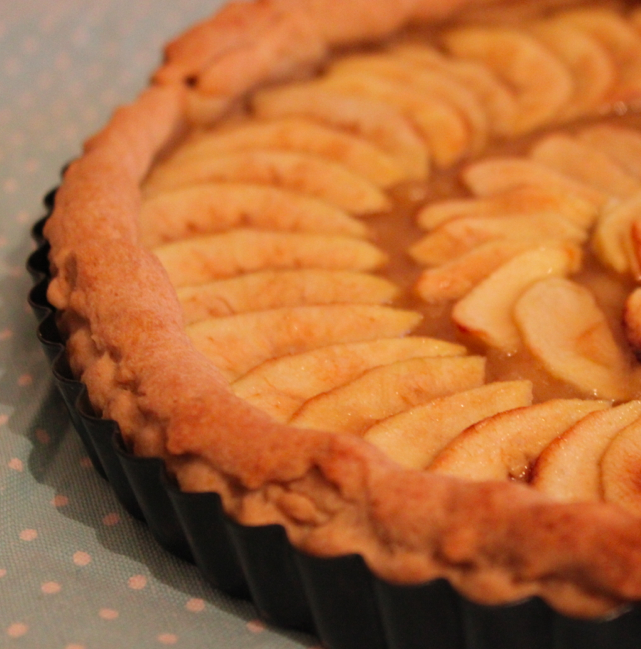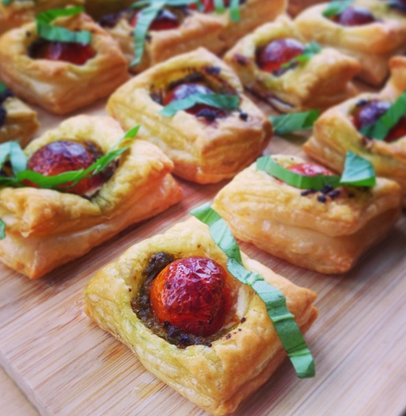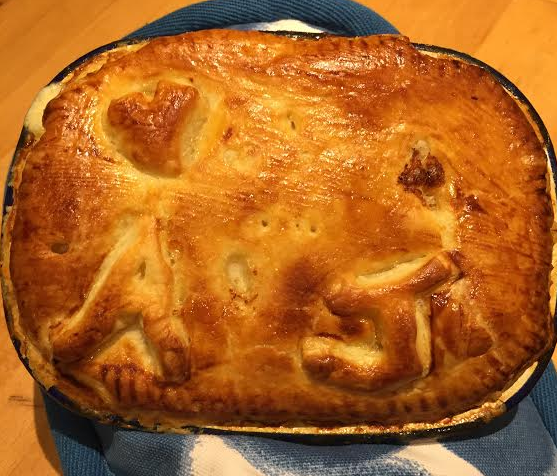Tarte Normande

I watched the chefs at Leiths make a Tarte Normande while at cookery school, and it was absolutely divine. This version is adapted from the recipe in the Leiths Cookery Bible (they tell me there’s a new version coming out in September, so if you’re looking for a new book, I’d wait till then).
The Tarte Normande is a rich buttery pastry tart, filled with frangipane and decorated with apples. As Louisa at Leiths pointed out, this tarte is more about the frangipane than the apples, but you could probably cover the whole of the top in apples if you felt so inclined. I really do recommend making your own pastry for this one as it’s pretty easy and it’s so tasty – nothing beats buttery, rich, homemade pastry! Though if you’re short of time or you’re too scared, you can probably get away with shop bought sweet shortcrust. Frangipane is traditionally made with ground almonds, but I went for ground hazelnut as I prefer the flavour. You could opt for almonds if you prefer.
Serves 8 ish
You will need:
for the pastry
- 250g plain flour
- 110g 4oz butter
- 1 egg yolk
- ¾ level teaspoon salt
- 1 tbsp caster sugar
- 2 – 3 tablespoons cold water
for the frangipane
- 200g butter
- 200g caster sugar
- 2 eggs
- 2 egg yolks
- 1 tbsp Calvados
- 200g roasted hazelnuts without their skins
- 3 – 4 ripe braeburn (or similar dessert/eating) apples
- 3 tbsp of sieved apricot jam
- 1 tbsp sugar
- juice of one lemon
- Start off by making your pastry case. Pop your flour and chilled butter into a food processor and pulse it until you have a fine breadcrumb texture. Be careful not to whizz it up too much – you don’t want it to start to form a dough. You can do this by hand if you prefer, but make sure your hands are chilly (run ‘em under a cold tap if necessary) so you protect the butter from melting. When the mixture resembles breadcrumbs, stir in the salt and the sugar.
- Lightly beat the egg yolk in a mug with a fork. Add 2 tablespoons ice cold water and beat until you have a smooth consistency – should only take 10 seconds. Add the egg yolk to the flour mixture and mix in with a palette knife. If you use the blade to gather the mix against the bowl, it will start to form a dough. You might need another tbsp of water if it’s looking very dry. When a rough dough is forming, rinse your hands under the cold tap, dry them thoroughly, then bring the dough together until a smooth even ball.
- Roll the pastry out so that it’s big enough to fit a 12” tart tin (I actually used a loose bottom cake tin for mine). Use a sparing amount of flour and try to roll it as evenly as possible. I rolled it over the loose bottom of the cake tin, then picked up the base quickly and carefully before placing it in the tin. Quickly make sure your pastry edges are tucked into the middle of the tin – if they’re flopping over the edge they can become very weak and can break off. Now carefully press the pastry into the tin so that the sides are evenly covered and there are no loose bits of weak areas. Carefully trim off the excess pastry. I actually had enough spare pastry to make another mini tart! :) Neaten up the edges of the pastry as best you can, cover it in cling film, then pop in the fridge for 40-60 mins.
- Put a baking sheet in the oven and preheat to 200°c.
- When your pastry case is cold and firm, take it out of the fridge. Prick the bottom of the pastry all over with a fork. Scrunch up a large piece of greaseproof paper and then use it to line the pastry. Add in some baking beans (or rice) until you have filled the case. Press it out to the sides – this will ensure the pastry sides don’t fall down while baking. Pop it in the oven for 15-30 mins – keep checking on it. You don’t want it to be any more than lightly golden. Over bake it and the pastry will be too dark and not very nice. After about 20 mins, you can carefully lift out the beans in their paper. Now paint the inside of the tart with some beaten egg and pop back in the oven for 10 mins or so until the base of the pastry is pale golden and no grey bits remain. Leave to cool.
- Next, make the frangipane. Start by measuring out your sugar. Next, pop your hazelnuts into a food processor with a tablespoon of your measured out sugar and blitz them until they’re finely ground. Set aside for later. Next, cream the butter in a bowl until it’s pale and fluffy. Beat in the sugar a little at a time, and beat until it’s soft and fluffy.
- Pop the eggs and egg yolks in a mixing jug and beat with a fork until they’re evenly mixed. Slowly add this to the sugar/butter mix, beating well after each addition. Turn the speed down, and add the Calvados followed by the ground hazelnuts and the flour. Spread it into the pastry case. I used a bit of spare frangipane in my mini tart. :)
- Peel the apples, cut then into quarters and remove the core. Cut the apples into very thin slices and arrange them on the frangipane. Traditionally you would do this like spokes on a wheel, keeping the slices of each half apple together. You can do whatever you like though to be honest.

Tarte Normande! The completed full size version! :) (photo by Ashley) - Bake the tart on the hot baking sheet for 10 – 15 minutes until the pastry turns a darker golden colour. Turn the oven down to 180C and bake for another 30 – 40 minutes or until the apples are tender and the frangipane is set. Give it a gentle shake on the tray – when it stops wobbling, it’s done.
- While it’s cooking, make the apricot glaze. Just add 3 tbsp of apricot jam to a small saucepan, with 1bsp sugar and the juice of a small lemon. Mix well and then reduce until it’s syrupy. Strain through a sieve and then set aside.
- When the tart is out of the oven, put it on a wire rack to cool. Gently dab the tart with the apricot glaze. Try not to brush it as this can left little brush marks on the tarte.
- Serve at room temperature with some extra thick double cream (mixed with a tbsp of Calvados if possible!) or some crème fraiche.
- This tart is best eaten the day it is baked, but it can be frozen. Just before serving, reheat in a low oven. It can also be partially made the day before – I left my pastry case (raw) in the fridge overnight and made the frangipane the day before as well. It’s fine in the fridge overnight but do take it out asap in the morning before baking so it can come up to room temperature.
Enjoy!








1 Response